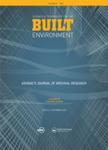版权所有:内蒙古大学图书馆 技术提供:维普资讯• 智图
内蒙古自治区呼和浩特市赛罕区大学西街235号 邮编: 010021

作者机构:United Technol Corp Control & Diagnost Syst Pratt & Whitney E Hartford CT 06118 USA United Technol Res Ctr Thermofluid Dynam Grp E Hartford CT 06108 USA Iowa State Univ Dept Mech Engn Ames IA USA Univ Calif Berkeley Dept Mech Engn Berkeley CA 94720 USA United Technol Res Ctr Embedded Syst Grp E Hartford CT 06108 USA
出 版 物:《SCIENCE AND TECHNOLOGY FOR THE BUILT ENVIRONMENT》 (国际供暖、通风、空调、制冷研究杂志)
年 卷 期:2015年第21卷第6期
页 面:734-751页
核心收录:
学科分类:08[工学] 0807[工学-动力工程及工程热物理] 081404[工学-供热、供燃气、通风及空调工程] 0802[工学-机械工程] 0814[工学-土木工程]
基 金:Humphrey's Engineer Support Activity [W912HQ-11-C-0016] Strategic Environmental Research and Development Program Environmental Security Technology Certification Program Office
主 题:fault-tolerant control diagnostic model Model predictive control algorithms Defect detection High Voltage Alternating Current Systems heating ventilation and air conditioning Predictive control Computer algorithms energy consumption
摘 要:This article presents the development and application of a fault-tolerant control technology, its online implementation, and results from several tests conducted for a large-sized HVAC system. By integrating model-based model predictive control and data-driven fault detection and diagnosis algorithms, the technology automatically adapts the HVAC control laws to a set of subsystem faults and can therefore reach and maintain the largest energy consumption reduction levels that are achievable at any point throughout a building lifecycle. The model predictive control algorithm generates optimal set-points that minimize energy consumption for the HVAC actuator loops while meeting equipment operational constraints and occupant thermal comfort constraints. The fault detection and diagnosis algorithm uses probabilistic graphical models to detect and classify in real time potential faults of the HVAC actuators based on data from multiple sensors. The fault-tolerant control system is realized by executing the two algorithms on the same platform, within the same framework, and by using the fault detection and diagnosis algorithm s output to continuously update the model predictive control algorithm constraints. The proposed integrated technology is executed at the supervisory level in a hierarchical control architecture as an extension of a baseline building management system. The performance and limitations of the fault detection and diagnosis, model predictive control, and fault-tolerant control algorithms are illustrated and discussed using measurement data recorded from multiple tests.